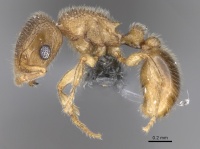Tetramorium hirsutum
| Tetramorium hirsutum | |
|---|---|

| |
| Scientific classification | |
| Kingdom: | Animalia |
| Phylum: | Arthropoda |
| Class: | Insecta |
| Order: | Hymenoptera |
| Family: | Formicidae |
| Subfamily: | Myrmicinae |
| Tribe: | Crematogastrini |
| Genus: | Tetramorium |
| Species: | T. hirsutum |
| Binomial name | |
| Tetramorium hirsutum Collingwood & van Harten, 2005 | |
Described from a type collection found in a malaise sample.
Identification
Collingwood & van Harten (2005) -This small species differs from others in the same size range by the clypeus with its median notch, distinct antennal scrobes, excessive pilosity and the smoothly rounded alitrunk dorsum. This combination of characters seemingly excludes this species from any of the groups listed by Bolton (1980) in the Afrotropical zoogeographic region.
Keys including this Species
Distribution
Latitudinal Distribution Pattern
Latitudinal Range: 13.06666667° to 13.06666667°.
| North Temperate |
North Subtropical |
Tropical | South Subtropical |
South Temperate |
- Source: AntMaps
Distribution based on Regional Taxon Lists
Afrotropical Region: Saudi Arabia, Yemen (type locality).
Distribution based on AntMaps
Distribution based on AntWeb specimens
Check data from AntWeb
Countries Occupied
| Number of countries occupied by this species based on AntWiki Regional Taxon Lists. In general, fewer countries occupied indicates a narrower range, while more countries indicates a more widespread species. |

|
Estimated Abundance
| Relative abundance based on number of AntMaps records per species (this species within the purple bar). Fewer records (to the left) indicates a less abundant/encountered species while more records (to the right) indicates more abundant/encountered species. |

|
Biology
Castes
Worker
Images from AntWeb
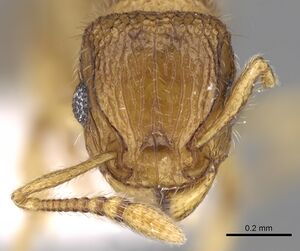 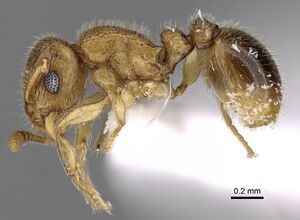 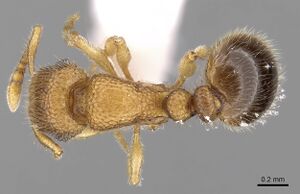 
| |
| Worker. Specimen code casent0280976. Photographer Estella Ortega, uploaded by California Academy of Sciences. | Owned by CAS, San Francisco, CA, USA. |
   
| |
| Worker. Specimen code casent0906351. Photographer Estella Ortega, uploaded by California Academy of Sciences. | Owned by KSMA; KSU, King Saud University Museum of Arthropods. |
Queen
Images from AntWeb
 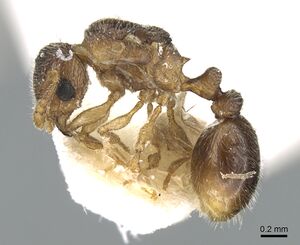  
| |
| Queen (alate/dealate). Specimen code casent0906350. Photographer Estella Ortega, uploaded by California Academy of Sciences. | Owned by KSMA; KSU, King Saud University Museum of Arthropods. |
Nomenclature
The following information is derived from Barry Bolton's Online Catalogue of the Ants of the World.
- hirsutum. Tetramorium hirsutum Collingwood & van Harten, 2005: 76, fig. 4 (w.q.) YEMEN.
Unless otherwise noted the text for the remainder of this section is reported from the publication that includes the original description.
Description
Worker
TL 2.36 (2.25-2.37), HL 0.61, HW 0.53, ScL 0.36, PW 0.24, PPW 0.27, Eye L 0.145. The mandibles are clear with scattered punctures. The clypeus is notched; the segmented antennae have wide, well-developed scrobes. In dorsal view the pronotum is sharply angled, the propodeum has short strong teeth, the nodes are slightly broader than long with rounded sides. In profile the· alitrunk is a smoothly rounded dome. The head and alitrunk have longitudinal rugose sculpture. All surfaces including antennae and legs are clothed with dense fme short hairs. Colour light brown.
Queen
TL 2.53, HW 0.59. The scrobes are well developed, the general body sculpture is more reticulopunctate than that of the worker, pilosity dense as in the worker.
Type Material
Holotype: worker, Lahj, IX.2000, in Malaise trap, A. VAN HARTEN & A. SALLAM leg. Paratypes: queens and workers, same data as holotype. The types of the new species will be deposited in the Liverpool Museum, Liverpool, UK.
References
- Borowiec, L. 2014. Catalogue of ants of Europe, the Mediterranean Basin and adjacent regions (Hymenoptera: Formicidae). Genus (Wroclaw) 25(1-2): 1-340.
- Collingwood, C. A. and A. van Harten. 2005. Further additions to the ant fauna (Hymenoptera: Formicidae) of Yemen. Zoology in the Middle East. 35:73-78. (page 76, worker described)
